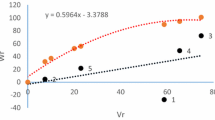Abstract
Despite efforts made, forage yield of smooth bromegrass has increased slowly over the last 50 years of breeding. It therefore seems necessary to investigate more on the genetic basis of agro-morphological traits in this cool-season, highly drought resistant grass. The present study was aimed at estimation of total genetic variance, narrow-sense heritability, general combining ability, phenotypic and genotypic correlation among different quantitative traits in half-sib (HS) families derived from polycross of 25 smooth bromegrass genotypes that were mainly originated from Iran. Families differed significantly for all of the agro-morphological and quality traits measured. Narrow sense heritability (\({\text{h}}_{\text{n}}^{2}\)) ranged from about 0.2 (plant height) to 0.7 (day to inflorescence emergence and day to anthesis). Moderate to high heritability for forage dry matter yield (0.42) indicates that phenotypic selection for this trait can be successful. A wide range of general combining ability was observed for most of the studied traits, especially those related to forage yield. Relatively low genetic variation and heritability for crude protein and also negative correlation of this trait with forage yield, indicates a low probability of improving forage yield and quality simultaneously.
Similar content being viewed by others
References
Aastiveit AH, Aastiveit K (1990) Theory and application of open pollination and polycross in forage grass. Theor Appl Genet 79:618–624
Amini F, Majidi MM, Mirlohi A (2013) Genetic and genotype x environment interaction analysis for agronomical and some morphological traits in half-sib families of tall fescue. Crop Sci 53:411–421
Araujo MRA (2001) Variation and heritability in meadow bromegrass (Bromus riparius Rehm.). PhD Thesis, Univ. of Saskatchewan, Saskatoon, Canada
Araüjo MRA, Coulman BE, Rakow G (2002) Genetic variation, heritability and progeny testing in meadow bromegrass. Plant Breed 121:417–424
Asay KH, Carlson IT, Wilsie CP (1968) Genetic variability in forage yield, crude protein percentage, and palatability in reed canarygrass, Phalaris arundinacea L. Crop Sci 8:568–571
Barker RE, Kalton KK (1989) Cool season forage grass breeding: progress, potentials, and benefit. In: Sleper DA, Assay KH, Pedersen JF (eds) Contribution from breeding forage and turf grasses. crop science soc. of America (CSSA) (special publication no.15)., pp 5–20
Berg CC, Hill RR (1983) Quantitative inheritance and correlations among forage yield and quality components in timothy. Crop Sci 23:380–384
Burton GW (1989) Progress and benefits to humanity from breeding warm-season forage grasses. In: Sleper DA, Assay KH, Pedersen JF (eds) Contribution from breeding forage and turf grasses. crop sci soc of America (Special Publication No. 15)., pp 21–29
Casler MD (1998) Genetic variation within eight populations of perennial forage grasses. Plant Breed 117:243–249
Casler MD, Carlson IT (1995) Smooth bromegrass. In: Barnes RE, Miller DA, Nelson CJ (eds) Forages: an introduction to grass land agriculture, 5th edn. Iowa State Univ Press, Ames, pp 313–324
Casler MD, Vogel KP, Balasko JA, Berdhal JD, Miller DA, Hansen JL, Frits JO (2000) Genetic progress from 50 years of smooth bromegrass breeding. Crop Sci 40:13–22
Comstock RE, Robinson HF (1952) Genetic parameters, their estimation and significance.In: Proc. 6th Int. grasslands congress, pp 1284–1291
Ferdinandez YSN, Somers DJ, Coulman BE (2001) Estimating the genetic relationship of hybrid bromegrass to smooth bromegrass and meadow bromegrass using RAPD markers. Plant Breed 120:149–153
Gould FW, Shaw RB (1983) Grass systematics, 2nd edn. Texas A&M Univ Press, College Station
Hill RR (1977) Quantitative genetics of forages: potentials and pitfalls. Am Soc of Agron Abstracts, Madison
Hill HD, Carnahan HL (1957) Karyology of natural 4×, 6× and 8× progenies of a tetraploid (4×) clone of Bromus inermis Leyss. Agron J 49:449–452
Jafari A, Naseri H (2007) Genetic variation and correlation among yield and quality traits in cocksfoot (Dactylis glomerata L.). J Agricultural Sci 145:599–610
Knowles RP (1950) Studies of combining ability in bromegrass and crested wheatgrass. Sci Agric 30:275–302
Majidi MM, Mirlohi A, Amini F (2009) Genetic variation, heritability and correlations of agro-morphological traits in tall fescue (Festuca arundinacea Schreb.). Euphytica 167:323–331
McDonald EE, Kalton RR, Weiss MG (1952) Interrelationships and relative variability among S1 and open pollination progenies of selected bromegrass clones. Agron J 44:20–24
Meyer WA, Funk CR (1989) Progress and benefits to humanity from breeding cool-season grasses for turf. In: Sleper DA, Assay KH, Pedersen JF (eds) Contribution from breeding forage and turf grasses. crop science soc. of America (CSSA).(Special Publication No. 15)., pp 31–48
Nguyen HT, Sleper DA (1983) Theory and application of half-sib matings in forage grass breeding. Theor Appl Genet 64:187–196
Nielson EJ, Smith DC (1961) Problems and methods in breeding smooth bromegrass (Bromus inermis Leyss.).In: Proc 8th Int Grassl Congr, pp 61–66
Ross JG, Bullis SS, Lin KC (1970) Inheritance of in vitro digestibility in smooth bromegrass. Crop Sci 10:627–633
SAS (1999) SAS/STAT users guide. SAS Institute Inc., Cary
Tan WK, Tan GY, Walton PD (1978) Genetic variability in acid detergent fiber, crude protein, and their association with some morphological characters in smooth bromegrass. Crop Sci 18:119–121
Vogel KP, Gorz HJ, Haskins FA (1981) Heritability estimates for forage yield, in vitro dry matter digestibility, crude protein, and heading date in indiangrass. Crop Sci 21:35–38
Vogel KP, Reece PE, Nichols JT (1993) Genotype and genotype–environment interaction effects on forage yield and quality of intermediate wheatgrass in swards. Crop Sci 33:37–41
Vogel KP, Moore KJ, Moser LE (1996) Bromegrasses. In: Moser LE, Buxton DR, Casler MD (eds.) Cool-season forage grasses. Agronomy Monograph No. 34, American Society of Agronomy, Crop Sci Soc of America, Soil Science of America, Madison, pp 535–567
Wricke G, Weber WE (1986) Quantitative genetics and selection in plant breeding. Walter de Gruyter, New York 406p
Author information
Authors and Affiliations
Corresponding author
Rights and permissions
About this article
Cite this article
Araghi, B., Barati, M., Majidi, M.M. et al. Application of half-sib mating for genetic analysis of forage yield and related traits in Bromus inermis . Euphytica 196, 25–34 (2014). https://doi.org/10.1007/s10681-013-1011-2
Received:
Accepted:
Published:
Issue Date:
DOI: https://doi.org/10.1007/s10681-013-1011-2




